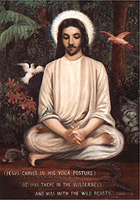 Today in Hindu homes and temples across the United States a striking image of divinity is on display. Dressed in a flowing white robe, his long hair pulled back behind slight shoulders, this holy man sits, half-lotus style, eyes cast down, in meditation. A halo rings his head, and his body is framed, St. Francis-like, by wild animals. "He was there in the wilderness," the accompanying text reads, "and was with the wild beasts" (Mark 1:13). Painted in the 1920s by Eugene Theodosia Oliver, a Catholic, in keeping with instructions from a Hindu monk, the image is called Christ the Yogi. This Jesus is clearly at peace with nature, with himself, and with God. He knows precisely who he is. And who he is, quite plainly, is a Hindu.
Today in Hindu homes and temples across the United States a striking image of divinity is on display. Dressed in a flowing white robe, his long hair pulled back behind slight shoulders, this holy man sits, half-lotus style, eyes cast down, in meditation. A halo rings his head, and his body is framed, St. Francis-like, by wild animals. "He was there in the wilderness," the accompanying text reads, "and was with the wild beasts" (Mark 1:13). Painted in the 1920s by Eugene Theodosia Oliver, a Catholic, in keeping with instructions from a Hindu monk, the image is called Christ the Yogi. This Jesus is clearly at peace with nature, with himself, and with God. He knows precisely who he is. And who he is, quite plainly, is a Hindu.The story behind the diffusion of this image-an image nearly as recognizable in U.S. Hindu circles as Warner Sallman's 'Head of Christ' is among U.S. Protestants-is the story of the Vedanta Society. It is also a tale of how Jesus became an American icon, and how American Hindus contributed to that transformation.
But first let's consider Jesus. His undeniable popularity here can be traced, of course, to the fact that the overwhelming majority of Americans are Christians. But if Christians had maintained a monopoly over interpreting Jesus, he would not have become a national celebrity. That distinction can be traced to the audacious efforts of America's freethinkers and Jews, Buddhists and Hindus who have, in a sense, stolen Jesus away from the organized churches, freeing him to be (in Paul's words) "all things to all people." Buddhists who follow the Dalai Lama see Jesus as a bodhisattva. Hare Krishnas worship Jesus as an incarnation of their Supreme Lord Krishna. Daoists call him the "Eternal Dao."
Meanwhile, congregants at the San Francisco Vedanta Society, where the original Christ the Yogi hangs, revere Jesus as a "great Yogin" with highly developed "psychic powers." These congregants trace their lineage back to Ramakrishna, an Indian mystic from West Bengal, who was graced with a vision of Jesus while meditating on the Madonna and Child in 1874. Soon his disciples were also cultivating the "Jesus state." Shortly after Ramakrishna's death in 1886, twelve of his followers gathered on Christmas Eve to discuss Jesus, his life of renunciation, and his realization of God-consciousness. Their leader, Swami Vivekananda, spoke of Jesus' life, death, and resurrection. He described how the apostle Paul had "preached the gospel of the Arisen Christ and spread Christianity far and wide." He said it was time for them to go and do likewise.
He returned to India in 1897, leaving behind Vedanta societies in major cities across the country. In these societies, Vedantists celebrated the birth of the "Oriental Christ" every Christmas Eve. "Meditate on Christ within," worshipers were told as they did darshan (sacred seeing) of Christ the Yogi, "and feel his living presence." And in Vedanta societies nationwide, they continue to revere Jesus as a divinity today.
At the Ramakrishna Vedanta Society of Boston, for example, Swami Tyagananda conducts a special service every Christmas Eve. There, in an elegant brownstone hard by the Charles River, forty to sixty congregants venerate Jesus by garlanding the same image of the Madonna and Child that once captivated their founder. Then they read the Nativity story from the King James Bible , heed the wisdom of the Sermon on the Mount, and listen to a homily on Jesus' life.
Unlike Christian ministers, Swami Tyagananda steers clear of proclaiming Jesus the only incarnation of the divine, since according to Vedantist teaching Jesus is one avatar among many--one of many periodic descents of divinity into the world. Tyagananda presents Jesus instead as a model of ego renunciation and simple living, quoting (by memory) from Luke: "Foxes have their holes and birds have nests but the Son of Man has nowhere to lay his head."
Christmas Eve at the Ramakrishna Vedanta Society of Boston also includes carols: "Silent Night," "Hark the Herald Angels Sing," and Tyagananda's personal favorite, "Go Tell it on the Mountain." ("So lively," he says, "I love that one.") After the service, congregants gather for a mixture of Indian and American treats, including Christmas cookies. They leave secure in the knowledge that, like so many other Americans, they are worshiping Jesus. But they are doing so in their own way.
Vedantists from Swami Vivekananda forward have typically divided Christianity into a true and a false form-the religion of Jesus and the religion about Jesus. Then they draw on the authority of the former to denounce what is wrong with the latter. "The religion of Christ, or true Christianity," one swami wrote, "had no dogma, no creed, no system, no theology. It was a religion of the heart, a religion without any ceremonial, without ritual, without priestcraft." (The abominations of "Churchianity," he says, came later.)
The most daring Vedantist reinterpreter of Jesus may have been Swami Trigunatita, the San Francisco Vedanta Society leader who commissioned Christ the Yogi. Echoing the Roman Catholic claim that there is "no salvation outside the church," Trigunatita wrote that the Vedantist teaching of the self-realization of divinity "alone leads you to the truth." "Will your baptism and acceptance of Christ as your Savior be able to save you?" he asked. "No. . . . Unless you realize yourself, no Bible, no doctrine, no amount of baptism can ever save you."
Trigunatita's position was not that other religious paths were futile. It was possible to realize your own equivalence with God through other faiths. But any person on the path to self-realization was in his view "a true Vedantist."
"No matter by what way, by what method you carry on your religious culture-be you a Christian, be you a Mohammedan, be you a Buddhist-so long as you are a sincere seeker after truth, you are a great Vedantist, you belong to Hinduism," he wrote.
"Hinduism is your religion."

